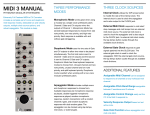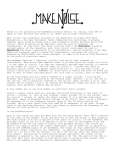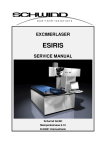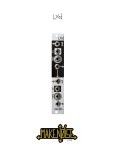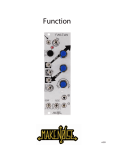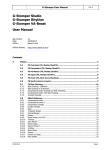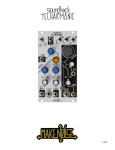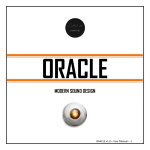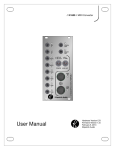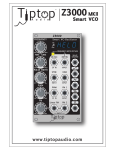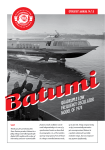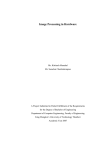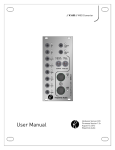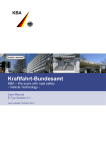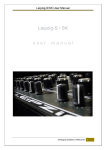Download Mysteron manual
Transcript
v. 2.0 This device complies with Part 15 of the FCC Rules. Operation is subject to the following two conditions: (1) this device may not cause harmful interference, and (2) this device must accept any interference received, including interference that may cause undesired operation. Changes / modifications not approved by the Make Noise Co. could void the user’s authority to operate the equipment. This equipment has been tested and found to comply with the limits for a Class A digital device, pursuant to part 15 of the FCC Rules. These limits are designed to provide reasonable protection against harmful interference when the equipment is operated in a commercial environment. This equipment generates, uses, and can radiate radio frequency energy and, if not installed and used in accordance with the instruction manual, may cause harmful interference to radio communications. makenoisemusic.com Make Noise Co., 414 Haywood Road, Asheville, NC 28806 Limited WARRANTY: Make Noise warrants this product to be free of defects in materials or construction for a period of one year from the date of purchase (proof of purchase/invoice required). Malfunction resulting from wrong power supply voltages, backwards or reversed eurorack bus board cable connection, abuse of the product or any other causes determined by Make Noise to be the fault of the user are not covered by this warranty, and normal service rates will apply. During the warranty period, any defective products will be repaired or replaced, at the option of Make Noise, on a return-to-Make Noise basis with the customer paying the transit cost to Make Noise. Please contact [email protected] for Return To Manufacturer Authorization. Make Noise implies and accepts no responsibility for harm to person or apparatus caused through operation of this product. Please contact [email protected] with any questions, needs & comments, otherwise... go MAKE NOISE! http://www.makenoisemusic.com THANK YOU: DSP Engineer: yerpa58 Lead Designer: Tony Rolando Assistant Design Engineer: Matthew Sherwood Beta Analyst: Walker Farrell, Lee Coleman, Devin Booze Test Subjects: Richard Devine, Surachai Inspiration: Ron Berry, Julius O. Smith, Karplus & Strong and Jaffe Electrocution Hazard! Always turn the Eurorack case off and unplug the power cord before plugging or un-plugging any Eurorack bus board connection cable cable. Do not touch any electrical terminals when attaching any Eurorack bus board cable. The Make Noise Mysteron is an electronic music module requiring 95 mA of +12VDC and 25 mA of -12VDC regulated voltage and a properly formatted distribution receptacle to operate. It is designed to be used within the Eurorack format modular synthesizer system. Go to http://www.makenoisemusic.com/systems.shtml for examples of Eurorack Systems and Cases. To install, find 14HP of space in your Eurorack synthesizer case, confirm proper installation of included eurorack bus board connector cable on backside of module (see picture below), plug the bus board connector cable into the Eurorack style bus board, minding the polarity so that the RED stripe on the cable is oriented to the NEGATIVE 12 Volt line on both the module and the bus board. On the Make Noise 6U or 3U Busboard, the negative 12 Volt line is indicated by the white stripe. -12V Please refer to your case manufacturers’ specifications for location of the negative supply. Overview Some say the definition of insanity is doing the same thing, over and over, expecting different results. By that definition, the Mysteron IS insanity. Simply put, it is a voltage controlled Digital Waveguide algorithm; however, that does not completely explain all of its behaviors. The Mysteron algorithm is a bit of a mystery even to those of us involved in its design. Despite being completely digital, it is highly organic, displaying variation in outcome often seen only in nature. It is a formless blob of DSP that you grow, modulate, and patch into new sonic territories- some vaguely recognizable and others completely otherworldly. For a long time, the Mysteron project had no name. It was later referred to as “Mystery Module” and then just “???” Finally, the module was named for the extraterrestrials in the long forgotten BBC television series: “Captain Scarlet and the Mysterons.” Those Mysterons discovered the secret of “retrometabolism” or “re-generation.” They had the ability to alter matter and to recreate the exact likeness of any object once the original object had been destroyed, or “de-generated.” Because the Mysteron algorithm shared some of these qualities (as well as a some unidentifiable behaviors), the name seemed to fit to those of us working on the project. PITCH1 PITCH2 fine !! cv router out wa ui veg de 2 wa v i de e gu 1 GENERATION EXCITE mutate EXCITE IMPULSE Map of the Mysteron. TYPE DEPTH 1 2 3 10 11 4 5 8 6 9 7 Mysteron Interface 1. Coarse Pitch Panel Control: Sets length of waveguide or perceived pitch of sound, roughly 5 octaves. Quantized Mode at Full CCW. 2. Mystery LED: Lights to indicate Mutations, flashes slowly on Bowed/ Cross-FeedBack Modes, and flashes quickly in Quantized Mode. 3. OUTput: around 10Vpp max (depending upon settings esp. IMPULSE), AC coupled. 4. Fine Pitch Control: adjust perceived pitch by +/- 12%. 5. Pitch 1 CV Attenuator: bi-polar attenuator for Pitch 1 CV IN. 6. Pitch 1 CV IN: exponential pitch control input. Not applicable in Quantized Mode. Range +/-5V. 7. Pitch 2 CV IN: exponential pitch control input. 0V to +5V, 0V to +3V in Quantize Mode. Response 1V/Oct. Engage Quantize Mode for superior tracking. 8. Excite LEDs: indicate excitation of the Mysteron. 9. Excite Inputs: Gate inputs for excitation. Mysteron will create no sound unless you patch something to at least one of these inputs. Requires Clock/ Gate signal amplitude of at least 1.5V and width of at least 6ms. 10. IMPULSE: sets strength of excitation, allowing for control over amplitude and harmonics. Operates as Combo Knob, with nothing patched to IMPULSE CV IN, works as standard panel control. With Signal Patched to IMPULSE CV IN, works as an attenuator for that signal. Must be set greater than 0% to achieve audible sound. 11. IMPULSE CV IN: unipolar control input. Range 0V to +5V. 12 13 14 17 15 18 16 20 19 Mysteron Interface (cont’d) 12. DEPTH: sets how much the waveguides are Mutated. Operates as Combo Knob, with nothing patched to DEPTH CV IN, works as standard panel control. With Signal Patched to DEPTH CV IN, works as attenuator for that signal. 13. DEPTH CV IN: unipolar control input. Range 0V to +5V. 14. TYPE: sets the Type of Mutation. 15. TYPE CV Attenuator: uni-polar attenuator for TYPE CV IN. 16. TYPE CV IN: control signal input for TYPE. Range 0V to +5V. 17. Generation: sets feedback of the output of the waveguides back to their inputs. No feedback at NOON, CCW from NOON is De-Generative Feedback. Cw from NOON is Re-Generative Feedback. 18. Generation CV Attenuator: bi-polar attenuator for Generation CV IN. 19. Generation CV IN: control signal input for Generation. Range +/-4V. 20. !! IN: Gate input for determining algorithm behavior. With MUTATION DEPTH Full CCW, changes response of EXCITE parameter for bowed attack. With MUTATION DEPTH not full CCW, cross couples feedback paths of waveguides into each other. Mystery LED Flashes to indicate. Requires Clock/ Gate signal amplitude of at least 1.5V and width of at least 6ms. MAKING SOUND with the MYSTERON! At the bottom of the Mysteron there are two EXCITE Inputs, along with LEDs to indicate activity. The Mysteron will make no sound unless you patch something to at least one of the EXCITE inputs. When the Mysteron is EXCITED, a burst of energy (in the form of noise and other waveforms) is injected into the waveguide. The IMPULSE parameter sets the strength of this Excitation, thus allowing for control over both amplitude and harmonics. IMPULSE must be set greater then 0% to achieve audible sound. At lower settings the sound will have fewer harmonics and less impact. This parameter could also be used as a digital VCA while the Mysteron is Self-Oscillating. The EXCITE inputs are wired in a normalization scheme so that with either one patched, the other is triggered as well. Using BOTH EXCITE inputs will result in the two waveguides to have different lengths, with the possibility of creating two independent pitches and timbres. CONTROLLING the PITCH of the MYSTERON! The Pitch control sets the length of BOTH waveguides. The length of the waveguide will determine the perceived pitch of the resulting sound. It will also alter the timbre of the sound. The PITCH control, Pitch 1 and Pitch 2 all have an Exponential response with a range of roughly 5 octaves. At the lowest end of this range, the sounds are lower pitched and take longer to decay. Therefore, it is harder to discern the pitch, as there is greater harmonics. At the middle of this range the sounds are shorter and have fewer harmonics, making it easier to discern their pitch. At the highest end of this range, the sounds have the potential to become so short it is hard to determine the pitch. Changes to the PITCH controls are applied to the most recently Excited waveguide. If both waveguides are Excited together, then both are same length. The EXCITE inputs are normalled so patching into just one Excites both together. Using BOTH EXCITE Gate Inputs independently, it is possible to have the two waveguides at different lengths, thus making two differently-pitched sounds. Removing all modulation from the Pitch 1 CV IN, and setting the PITCH panel control to Full CCW, will engage the Quantize Mode. The Mysteron will remain in Quantize Mode as long as the PITCH parameter control remains at 0% (PITCH panel control Full CCW and nothing patched to Pitch 1 CV IN). Quantize Mode is indicated by a the double Flashing of the Mystery LED and forces the Mysteron to a 12 tone Chromatic scale with the pitch determined by Pitch 2 CV IN. This is excellent for using the Mysteron in a melodic way alongside other sound sources such as an STO or DPO VCO. SCULPTING the SOUND of the MYSTERON Once the Mysteron is Excited the Generation parameter sets the feedback of the output of the waveguide back to the input. De-generative feedback saps energy from the algorithm, making the sounds shorter and more percussive. Re-Generative Feedback grows energy in the algorithm making the sounds longer and less percussive. At 100% Feedback the sound is almost a bowed type dynamic. With DEPTH full CCW (no MUTATION), the !! input engages an alternate response to the EXCITE inputs for a bowing effect. With DEPTH greater then 0%, the !! Gate Input cross couples the output of each waveguide into the input of the other waveguide. This is influenced by the analog acoustic modeling synthesis of Ron Berry. With Mutations occurring the results are more complex and depend upon the Type and Depth settings. The Mystery LED Flashes to indicate these behaviors. The MUTATION section features contains the Depth and Type controls. With Depth set full CCW, Type will do nothing. To hear the effects of Type control Depth must be turned to at least 10%. Depth sets the amount of mutated energy injected into the waveguide and Type selects the form of mutation. What is actually happening is that the waveguide is being excited more then just Noise. The Type control is scanning through other waveforms to be used to excite the waveguide. Depth blends these other waveforms with the Noise (from 0% WT 100% Noise to 100% WT 0% Noise). This dramatically changes the timbre AND Pitch of the sound. The Mystery LED lights to indicate Mutation. All other controls (PITCH, IMPULSE, GENERATION, !!) are still effective during MUTATION. Tip & Tricks 1. Mysteron must be EXCITED at some point to make any audible sound. 2. Setting Generation to 100% Re-Generation, the Mysteron will Self-Oscillate once the initial Excitation occurs. 3. Be sure IMPULSE is set to greater then 0% to achieve audible sound. 4. IMPULSE parameter could be used as digital VCA. 5. For melodic tracking, set PITCH panel control Full CCW (Quantize Mode) and use only PITCH 2 . Fine Tune will help to match the Mysteron to a VCO tuning. 6. For simplest usage, patch Gate or Clock to only one EXCITE input. 7. Using BOTH EXCITE inputs may result in the two waveguides to having different pitches, with the possibility of creating a duophonic behavior. Patch Ideas Digital Hi-Hats Set PITCH to ~12:00, IMPULSE between 12:00 and 1:00, DEPTH Full CW, GENERATION Full CCW, TYPE between 12:00 and full CW. Send gate stream to one or both EXCITE inputs, and select TYPE of your choice. Modulate TYPE, IMPULSE and PITCH for variation. Duophonic/Sample & Hold "Chords" Because the Pitch2 CV affects only the most recently struck waveguide, the EXCITE inputs behave similarly to sample & hold circuits when struck independently, giving rise to duophonic behavior. Use one fast and one slow gate stream to hear the effects. For example, set René into a four-row snake pattern with all gates enabled on the X- and Y- Gate pages. Use the X-Gate to excite one waveguide and the Y-gate to excite the other. The waveguide excited by the Y-gate will play a new note every four steps, while the other plays a new note every step. Higher GENERATION values will make the effect more obvious. Wavetable Oscillator Adjust GENERATION panel control full CW, and DEPTH full CW. Hit the EXCITE input with a single gate. The Mysteron will now continue to oscillate until GENERATION is turned down. Use TYPE control and/or CV input to select wavetables. Patch to VCA or use IMPULSE to emulate one. Voltage Controlled Quantize Mode Becausee the Pitch 1 CV input is summed with the Pitch panel control, it can be used for automated switching in and out of Quantize Mode. With Pitch full CCW (thus enabling Quantize Mode, patch a gate to the Pitch 1 CV input. Adjust input attenuator to taste (positive side only). If tracking is not critical, you can fine-tune the attenuator value and/or patch a stepped voltage such as a tuned voltage from Pressure Points, for voltage controlled transposition. Industrial Guitar Tones Tune DPO VCOB to a fifth, octave, or octave + fifth above Mysteron. Adjust Fold to ~9:00, Shape between 12:00 and full CW, Angle to 12:00. Patch Mysteron output to ModDemix Signal Input, DPO Final output to ModDemix Carrier/CV Input. Add character to the tone by increasing DEPTH. The lower half of the TYPE control will produce the most "tonal" results, with more noise occurring in the upper half. Subtle modulation of DPO ANGLE creates pleasing ripples of movement. Patch Ideas (cont’d) Typical Voltage Controlled Twangdoodle Patch Pressure Points common Gate Out to René X-Clk, and Pressure Points Gates 1 and 3 to Y-Clk. Set René to Cartesian mode and enable all steps on the Access page. Program a sequence with lower notes toward the bottom of the René grid, and higher notes toward the top. Patch René X and Y gates to EXCITE inputs on Mysteron. Engage Quantize mode and patch René QCV to Mysteron Pitch2 input. Play Pressure Points and René. Think of Pressure Points as your "pick" hand and René as your "fret" hand. Pressure and tuned voltage outputs can be utilized to other Mysteron parameters for more complex control, "palm mutes", harmonics etc.










